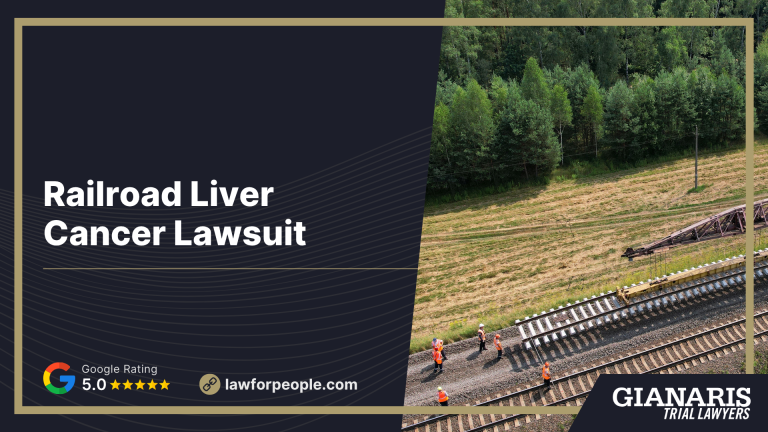Liver cancer has become a serious concern for many current and former railroad workers, especially those with long-term exposure to toxic substances on the job.
The railroad industry historically relied on materials and processes that released diesel exhaust, benzene, asbestos, and industrial solvents, chemicals now known to cause cellular damage in vital organs like the liver.
Prolonged exposure to these carcinogens can result in mutations that may lead to liver cancer, lung cancer, and other occupational diseases.
Railroad workers who developed liver cancer after years of service may be eligible to file a railroad cancer lawsuit under the Federal Employers Liability Act (FELA).
This law allows injured workers to seek compensation from railroad employers that failed to protect them from hazardous working conditions.
Many of these cancer claims argue that inadequate ventilation, lack of proper safety protocols, and employer negligence contributed to unsafe levels of toxic exposure.
If you’ve received a liver cancer diagnosis after working in the railroad industry, it’s important to speak with an experienced railroad cancer lawyer to explore your legal options.
Scientific Research Supporting Liver Cancer Claims in Railroad Workers
The most persuasive science in railroad liver-cancer claims centers on long-term mixed exposures typical of legacy rail shops and cabs: diesel engine exhaust (rich in PAHs/nitro-PAHs), creosote/PAHs from railroad ties, chlorinated solvents used for degreasing (e.g., trichloroethylene (TCE), perchloroethylene (PCE), and metal/welding fumes, with occasional contact to other petrochemical aerosols.
Diesel exhaust is firmly established for lung cancer; for primary liver cancers (e.g., HCC) the epidemiology is limited/suggestive, so rail cases typically rely on biologic plausibility (oxidative stress, CYP-mediated activation, chronic hepatic inflammation and fibrosis) plus task-based exposure reconstruction rather than a single “smoking-gun” agent.
Studies and literature on liver cancer and occupational exposures include:
- IARC Monographs – Diesel Engine Exhaust (Vol. 105, 2012): Group 1 (carcinogenic to humans) for lung cancer; liver evidence limited. Crucial for documenting historically high inhalation burdens in enclosed cabs/shops and co-exposure to PAHs that can initiate hepatic oxidative damage.
- IARC Monographs – Polycyclic Aromatic Hydrocarbons (e.g., benzo[a]pyrene; Vols. 92/100F): Several PAHs classified Group 1/2A, with liver tumors in animals and strong mechanistic evidence (DNA adducts, mutagenicity). Supports claims involving creosote-treated ties and diesel soot deposition in roundhouses.
- IARC Monographs – Trichloroethylene (TCE; Vol. 106): Group 1 human carcinogen (kidney cancer) with consistent liver tumor findings in animals and mechanistic pathways (TCA/DCA metabolites causing peroxisome proliferation, genotoxic stress). Relevant to solvent degreasing in rail shops.
- IARC Monographs – Perchloroethylene (PCE): Group 2A (probably carcinogenic) with animal liver tumors and oxidative/cytotoxic mechanisms; pertinent where solvent cleaning and parts washing occurred.
- IARC Monographs – Vinyl Chloride (VCM; Vol. 100F): Group 1 for hepatic angiosarcoma and HCC in high-exposure settings; not universal in rail, but demonstrates that chlorinated petrochemical vapors can be decisive liver carcinogens where present.
- Welding Fumes (IARC Group 1, 2017): Established lung carcinogen; metal fume exposures (e.g., hexavalent chromium, nickel) produce systemic oxidative stress and hepatocellular enzyme perturbations, supporting a pro-carcinogenic milieu when combined with diesel/solvent aerosols.
- Transportation/metalworking cohorts (multiple case–control/cohort studies): Report elevated hepatobiliary signals where solvent/exhaust exposures were sustained; effect sizes vary with exposure assessment quality but buttress dose–response arguments in mixed-exposure settings.
- U.S. railroad diesel cohorts (Garshick, Laden, et al.): Quantify intense, chronic diesel exposure in operating crafts—indispensable for exposure magnitude/duration reconstruction that can be paired with liver endpoints in registry/claims analyses.
- OSHA/NIOSH standards (29 CFR 1910; Benzene, Methylene Chloride, Hazard Communication, Welding Fumes): Require monitoring, controls, and medical surveillance—probative on foreseeability and duty to protect under FELA negligence theories.
In practice, successful railroad liver-cancer claims (HCC/intrahepatic cholangiocarcinoma) document cumulative exposure to diesel/PAHs/solvents/welding fumes by job and era, explain mechanistic plausibility, and integrate medical work-ups that rule out competing causes (viral hepatitis, heavy alcohol use, metabolic liver disease) while showing how workplace exposure materially increased risk.
Railroad Jobs at Risk for Exposure to Dangerous Substances Linked to Liver Cancer
Not all jobs in the railroad industry carried the same level of risk, but several positions placed workers in direct contact with cancer-causing substances.
Those at the highest risk often worked around diesel-powered equipment, chemical cleaners, or contaminated infrastructure without proper protective gear.
Roles at elevated risk include:
- Diesel mechanics and maintenance crews regularly exposed to exhaust and fuel residue
- Locomotive engineers and conductors operating engines with limited ventilation
- Track maintenance workers handling railroad ties treated with creosote or other chemicals
- Sheet metal workers, pipefitters, and welders exposed to welding fumes and asbestos
- Yardmasters and equipment operators working in confined environments with poor air quality
Railroad workers exposed to these conditions are now filing liver cancer lawsuits, alleging that the companies failed to warn them about long-term health risks and did not provide adequate safeguards.
Can I File a Wrongful Death Lawsuit if My Loved One Passed Away of Liver Cancer?
Yes, surviving family members may be eligible to file a wrongful death lawsuit under the Federal Employers Liability Act (FELA) if their loved one passed away from liver cancer linked to railroad employment.
These lawsuits argue that the railroad industry exposed workers to hazardous substances without adequate safety measures, leading to fatal diagnoses.
Family members (such as spouses, children, or other dependents) can pursue compensation for medical expenses, lost wages, funeral costs, and the emotional toll of losing a loved one.
These claims often include evidence of occupational exposure to diesel exhaust, solvents, and other toxic substances known to damage the liver.
Claims also cite co-occurring conditions such as chronic obstructive pulmonary disease (COPD) that further complicated the victim’s health.
If you believe your loved one’s liver cancer was caused by prolonged exposure during railroad work, an experienced railroad cancer attorney can help you determine eligibility and take legal action on your family’s behalf.



